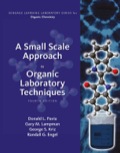
(a)
Interpretation:
The reason for fluorene to elute first from the column in the experiment mentioned in the question needs to be explained.
Concept Introduction:
The method of separation of components of the mixture is done by column chromatography techniques. This method is used to isolate the large number of components. The movement of solvent molecules in the thin layer chromatography takes place from bottom to top but in the column chromatography, the movement of mobile phase takes place from top to bottom in the column.
(b)
Interpretation:
The reason of changing the solvent in the middle of the column procedureneeds to be explained.
Concept Introduction:
The method of separation of components of the mixture is done by column chromatography techniques. This method is used to isolate the large number of components. The movement of solvent molecules in the thin layer chromatography takes place from bottom to top but in the column chromatography, the movement of mobile phase takes place from top to bottom in the column.
Want to see the full answer?
Check out a sample textbook solution
Chapter 5 Solutions
EBK A SMALL SCALE APPROACH TO ORGANIC L
 EBK A SMALL SCALE APPROACH TO ORGANIC LChemistryISBN:9781305446021Author:LampmanPublisher:CENGAGE LEARNING - CONSIGNMENT
EBK A SMALL SCALE APPROACH TO ORGANIC LChemistryISBN:9781305446021Author:LampmanPublisher:CENGAGE LEARNING - CONSIGNMENT Principles of Instrumental AnalysisChemistryISBN:9781305577213Author:Douglas A. Skoog, F. James Holler, Stanley R. CrouchPublisher:Cengage Learning
Principles of Instrumental AnalysisChemistryISBN:9781305577213Author:Douglas A. Skoog, F. James Holler, Stanley R. CrouchPublisher:Cengage Learning Macroscale and Microscale Organic ExperimentsChemistryISBN:9781305577190Author:Kenneth L. Williamson, Katherine M. MastersPublisher:Brooks Cole
Macroscale and Microscale Organic ExperimentsChemistryISBN:9781305577190Author:Kenneth L. Williamson, Katherine M. MastersPublisher:Brooks Cole



